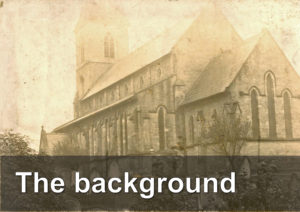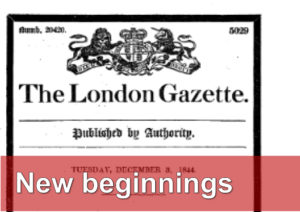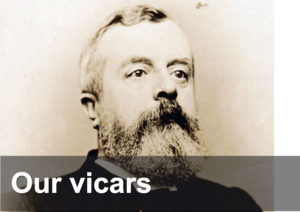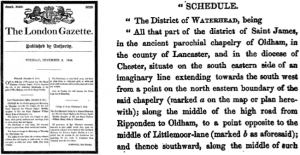 |
 |
 |
 |
 |
 |
Many local people felt that Waterhead needed its own Established Church. Historically, the village lay in the ecclesiastical Parish of Prestwich cum Oldham — as did virtually all of modern-day Oldham. Following the great Reform Act of 1832, the village was assigned to the new Parish of St James, although the nearest Established Church was outside Oldham in Hey or Lees: St John the Baptist is located about ½ mile away from the Waterhead Church.

The London Gazette announces the creation of the Waterhead ‘district’, in 1844. Issue 20420, page 5032. Right: after a legal preamble, the actual description of the new district commences.
The new Parish was still too large, and needed to be subdivided further. So it was possibly a relief when the London Gazette for Tuesday 3 December 1844 bore this pronouncement, ‘At the Court of Windsor, the 28th day of November 1844, PRESENT, The Queen’s Most Excellent Majesty in Council’ and then set out the legal apparatus for splitting the new Parish of Oldham into five separate ‘districts’. One of them was Waterhead.
So, in 1844, the Parish appointed the Revd Patrick Reynolds as its Perpetual Curate (incumbent) of the new Church. He will have known Oldham because he was then Perpetual Curate of Blackley, and had been since he became a priest in 1842. He had previously trained in Trinity College Dublin, obtaining a BA in 1841. He then passed the Bishop’s divinity test in 1842. Interestingly, he later obtained the legal degree LLB in 1855.
Reynolds’ task was colossal, for the new Parish stretched from Grains Bar, several miles beyond Moorside, to Millbottom on the bottom right of the map above.
The Waterloo and Peel Churches
The end of the Napoleonic Wars in 1815 created the first stability England had seen for almost a century. The peace brought a new sense of intellectual freedom and was accompanied by the creation of new industries, new political landscapes, and of course the new wealth that came with a cessation of war. A first fruit of this money and energy involved planning for a better future. That process also involved re-assessing the past through a re-discovery of history.
The first major change to affect the Church was a readjustment of the relationship between Parliament and the Church. The first Act of Parliament sponsored by this new mindset was the Church Building Act of 1818 which voted £1,000,000 toward the cost of building many new Anglican churches. The Parliamentary representatives who enacted the process were the Ecclesiastical Commissioners, so the new churches were soon called ‘Commissioners’ Churches’ (although some were also called ‘Waterloo Churches’ and ‘Million Act Churches’).
In many cases the Ecclesiastical Commissioners provided the full cost of the new church while in others they provided a grant with the balance being raised locally. The principal Commissioners’ Churches in Oldham are St James’, Barry Street (1829) and the rebuilt Parish Church (St Mary with St Peter, 1836).
In 1843, the Prime Minister, Sir Robert Peel, passed a similar Act ‘to provide better provision for the spiritual care of populous parishes’. The reason for the Act is rehearsed in its Preamble where it says ‘it is expedient to make better provision for the spiritual care of populous parishes’ and thereby ‘render the estates and revenues vested in the Ecclesiastical Commissioners, and the funds … applicable to such purpose’.
This far-reaching measure was soon termed the ‘Peel Act’. It permitted the first major boundary reforms of the modern age, thereby allowing the sub-division of geographically-large or overly-populated parishes, and thence created a series of smaller parishes.
The Act’s first precondition for a new parish was a population exceeding 4,000 souls—easily achieved for a rapidly industrialised town like Oldham. The town was duly ceded from the vast medieval Parish of Prestwich and thence subdivided into a series of new, more manageable parishes.
The core purpose of the Act was to enable local clergy to provide better spiritual care in these new and populous regions. So a central feature of the Act was providing endowments that paid a generous stipend for the new class of Vicars. The stipend was generally set at about £150; and the stipend at Waterhead was the same. The patronage of all the Peel Churches alternated between the Crown and the diocesan bishop.
The Act also created Church buildings, which were inevitably called ‘Peel Churches’. The Act stipulated that at least half the seats in each church should be free i.e. attending a service of divine worship did not necessitate the poor paying a pew rent. In effect, then, the Act was a form of suffrage for it legislated for the poor to have equal access to God.
The five Peel Churches of Oldham are St Mark’s in Glodwick (1844); Holy Trinity in Waterhead (1847); Holy Trinity in Coldhurst (1848), St Thomas’ in Werneth (1855), and the district church of St John’s in Chadderton. Although St Thomas’ Church in Lees was built at the same time and by Shellard, who designed Waterhead, it is not a Peel Church.
Revd Patrick Reynolds (1845–1854) Reynolds was the new ‘perpetual curate’ of Waterhead. This archaic phrase was in common use during the first half of the nineteenth century, and  meant an Incumbent who had no right to supplement his income from tithes, glebe, or other ancient endowments. After 1868, an Incumbent would have been styled ‘Vicar’. The living at Waterhead was such a perpetual curacy, in the alternating patronage of the Bishop of Manchester and the Crown. In common with all the Peel Churches, Reynolds’ salary as Incumbent was relatively high at £150 per annum. It was not high for Oldham, though, as the town was already one of the industrial powerhouses of the British Empire—indeed, one of the wealthiest towns in the world.
meant an Incumbent who had no right to supplement his income from tithes, glebe, or other ancient endowments. After 1868, an Incumbent would have been styled ‘Vicar’. The living at Waterhead was such a perpetual curacy, in the alternating patronage of the Bishop of Manchester and the Crown. In common with all the Peel Churches, Reynolds’ salary as Incumbent was relatively high at £150 per annum. It was not high for Oldham, though, as the town was already one of the industrial powerhouses of the British Empire—indeed, one of the wealthiest towns in the world.
Reynolds found lodgings at a local farm and made friends with a local surgeon, Dr Abraham Leach. At this time there was still no local church building so together they inspected several buildings that might accommodate a Sunday school for the children and a place of worship for adults. Services and Sunday-school classes were held in a room above two local cottages located in the Grove, a row of dwellings off Sidebottom Street, now demolished. The first congregation comprised Miss Beswick and half a dozen children, but the congregation grew very rapidly. These first worshippers, including the new Vicar, nicknamed the site, ‘The Old Cathedral.’
Incidentally, the Grove had been occupied in 1837 by the pioneers of the Congregational Church movement, when the Revd Galland , pastor of Greenacres Church, conducted Sunday evening services there until his death in 1834.

The ‘Old Cathedral’ in which Waterhead Church first started as a series of mission meetings in 1845. The photograph dates from about the same time as the Old Cathedral, and comes from a brochure for Waterhead Church’s 1903 Flower Festival.
Reynolds met with apathy from most people and open hostility from a few. But his enthusiasm and energy meant that numbers grew fast. The land on which the Church is built was formerly in the ownership of the Lord of the Manor of Ashton. It was converted to cotton spinning in about 1800, and soon acquired the name of Lower Mill. Four years before the founding of the Church, the land changed hands again when it passed to A R Sidebottom of Lincoln’s Inn, London, who gave the land to Reynolds for building a new Church. The land occupies a fairly steep rise on the left hand side of Huddersfield Road about a mile from the centre of Oldham. Unusually, it is situated on the extreme eastern boundary of the parish.
Reynolds raised sufficient money to start building the Church. Amazingly, the first stone was laid within three months of his arrival on 9 March 1845. When completed, the building was dedicated to the ‘Holy and Undivided Trinity’, and was consecrated on Trinity Sunday, 5 July 1847, by the Rt Revd John Sumner, the then Bishop of Chester. The Diocese of Manchester was founded slightly later that same year as a ceded section of the Chester Diocese). Sumner became Archbishop of Canterbury the following year.
Church Wardens were elected within a week of the dedication. In those days there were two, each with a slightly different role: Reynolds chose Mr T G Brideoake as the so-called Vicar’s Warden while the people chose Edward Mayall as their Warden. The latter was only 23. In those days, the latter’s role was entitled the Rate-Payer’s Warden because he was responsible for collecting pew rents. Both Wardens were generous benefactors of the new Church, and both have local roads named after them.

The Church was built to a design by E H Shellard. The left image shows the ground floor with the original distribution of pews, while the right image shows the gallery. © Lambeth Palace Library, and is reproduced with the kind permission of the Church Commissioners.

The ‘Sentence of consecration: a legal document signed by Bishop Sumner proving the Church had been consecrated according to canon law. The intricate calligraphy inside the document runs to many thousands of words.
1847 at a glance
Politics The Factory Act became law, and established a maximum 10-hour working day for women, and for boys aged 13–18. The Whig Party later won the general election under Lord John Russell; and the rebuilt Lords’ Chamber in the Palace of Westminster was completed to the design of Charles Barry.
Firsts The world’s first civic public park opened at Birkenhead in Merseyside; the first steam railcar was designed and built by James Samuel and William Bridges Adams; and the world’s first Vegetarian Society was formed.
Births The Scottish-born inventor of the telephone, Alexander Graham Bell; the suffragist and feminist Millicent Fawcett; the novelist Bram Stoker (whose most famous work was Dracula); the comic writer George Grossmith.
Deaths The palaeontologist Mary Anning; the painter William Simson; the chemist Charles Hatchett; the popular hymn writer Henry Francis Lyte, whose most famous hymns are probably Abide with me! and Praise, my soul, the King of Heaven.
Literature The following were published, or the first episode appeared in serial form: Anne Brontë’s Agnes Grey, Charlotte Brontë’s Jane Eyre, Emily Brontë’s Wuthering Heights, Frederick Marryat’s The Children of the New Forest and William Makepeace Thackeray’s Vanity Fair.
Science George Boole formalised his ‘symbolic logic’, which led to the Boolean algebra that drives the modern computer; Ignaz Semmelweis first prevented the transmission of puerperal fever; James Young Simpson discovered the anaesthetic properties of chloroform and first used it on an obstetric patient.
